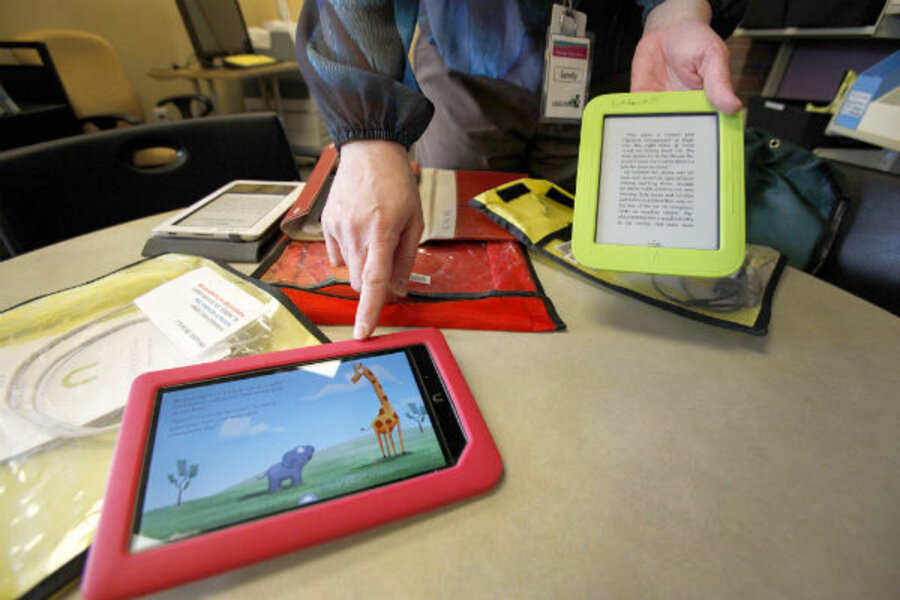How to get children to read? Embrace the e-book
Loading...
A lot of us parents worry that the expansion of digital technology into our children’s lives will result in them reading less than kids of previous generations.
It turns out that we needn’t worry at all. Children today are reading more than ever, in both digital and print forms, says a Scholastic Kids and Family Reading Report.
What steps can parents take to ensure their kids become enthusiastic lifelong readers?
Embrace the e-Book
Half of children ages 9-17 say they would read more books for fun if they had greater access to e-books, according to the Scholastic report. E-books, in particular, are motivating boys and reluctant readers, who are reading e-books for fun in record numbers. E-books needn’t replace the printed book – 80 percent of kids who read e-books still read print books for fun. Having multiple options simply means more reading opportunities in many children’s lives.
Take your Reading with You
Tablets and e-readers make it easier than ever to take your reading along wherever you go – in the car and during other travel, in waiting rooms, and local parks. And there are increasingly more great devices for reading e-books. The digital subscription service Bookboard provides access to a library of children’s books (audio and non) for the tablet, in a playful system that harnesses the natural interest kids have for technology and helps to motivate them to read by rewarding them with books appropriate for their age, reading level, and interests. Audio books, in particular, have proven a very effective tool for kids who have difficulty reading.
Use your Public Library
Libraries are still extremely popular, says a Pew Report on Library Services in the Digital Age. As many as 91 percent of people say that libraries are important to their communities and families. Libraries provide early literacy programming to support parents’ role as their children’s first teachers. They serve as community hubs and help bring families together. They invite hands-on experiential learning that prepares kids for reading and school. They provide access to technology and support digital learning in a way that may not be available to families at home. All this makes libraries a great place for readers and pre-readers alike to enjoy the array of services and foster a lifelong love of reading.
Look for “Readable” Moments
Books aren’t the only places kids learn to read. Reading opportunities are all around us. When you’re walking with your child, point out letters and read signs out loud. Make a game of this by searching for certain letters and words (or have children search while they’re in the car). When your baby or toddler is playing or when you’re performing chores at home, narrate what you or they are doing.
“You’re building with blocks.” “I’m washing the dishes.”
It might seem silly at first, but children initially learn the skills that lead to speaking and reading by listening to you.
In addition, kids often enjoy making lists. Even if the “words” consist of scribbles and lines, that’s the way they begin to read and write. Lists can be used to make menus for playing restaurant or receipts for playing store. Older children can help read recipes and make shopping lists and then help read the items in the store.
Set a Great Example
One of the most effective tools for encouraging kids to read is to be readers ourselves. Try to set aside time for your own reading where your children can see you (and read side-by-side with them when they’re older). Read a variety of media. Make a habit of reading to your kids as often as possible.
Some of my family’s fondest memories involve bonding over childhood books. Bedtime is a natural time for winding down and cuddling through reading, but some kids enjoy bath time so much that that can be an ideal time to share a book. Young children treasure time with their parents and when you spend some of that time reading, they’ll associate it with your presence and physical closeness and the sound of your voice.
Enjoy fostering your child’s lifelong interest in reading.
This post originally appeared in Dot Complicated.
The Christian Science Monitor has assembled a diverse group of the best family and parenting bloggers out there. Our contributing and guest bloggers are not employed or directed by the Monitor, and the views expressed are the bloggers' own, as is responsibility for the content of their blogs. Susan Sachs Lipman blogs at Slow Family Online.








